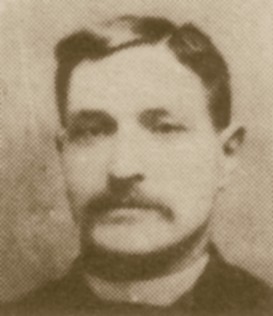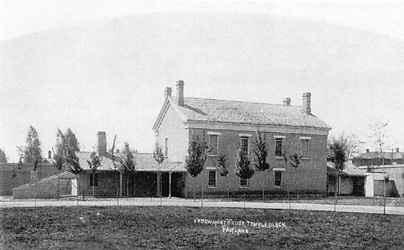|
|
|||||||||||||||||||||||||||||||||||||||
|
Fannie Call Barlow Born 11 August 1860 Bountiful, Utah |
|
|||||||||||||||||||||||||||||||||||||
|
|
Source of this biographical sketch Taken from the "The Life Story of Truman Heap Barlow including his forbearers, immediate kinfolk and posterity." Sponsored by Kimber C. Barlow Compiled and edited by Leo J. Muir An original copy of this book is available in the University of Utah Americana collection CS B32 1961 Fanny CALL Barlow was born 11 August 186o, Born on the Old Call homestead Fanny Call was born on the Old Call homestead, in the big home which still stands just north of the Reuben Call property on Second West. In her girlhood Fanny was afforded the somewhat meager schooling then provided in that farming community. However, the primitive facilities of learning in the public school were favorably supplemented by the religious instruction maintained even in that early era of Mormon history. The auxiliary organizations of the church-Sunday School and Primary Assn.-and the weekly Sacrament service on the Sabbath Day, were agencies of refinement and soul development. Fanny Call and her brothers and sisters experienced a wholesome, though humble home life. The Anson Call homestead consisted of many acres of choice land, adaptable to the growing of vegetables and fruits of a wide variety. Some of these lands were in the gravel and sand areas of the valley, others in the area of dark loamy soil. Near the Anson Call homes were orchards of fruit trees, including several black walnut trees, and in the field were sizeable patches of sugar cane which Father Call processed into sorghum, or molasses. On this farm also were fields of corn, and many acres of potatoes and other vegetable and fruits. Thus, the one occupation of the families of Anson Call was farming and gardening, which included livestock (horses and cattle, and pigs) and dairying and poultry raising. This farm adventure had to produce almost the full range of the foodstuffs for the home. Hence there was a home garden from which came a variety of berries, fruits and fresh vegetables. While the male members of the family cultivated, irrigated and garnered the hay, grain and vegetables for sale in Salt Lake City, the girls were brought into service in the care of the home garden, the picking of berries and the gathering of the peas, beans, etc. for home use and canning for the winter season, and to be marketed in Salt Lake City. Thus the girls learned something of the science of agriculture and much of the domestic sciences and arts. The Call families had more girls than boys. Hence, many young men in the Bountiful area had the good fortune to find their wives among the lovely daughters of the Call homes. These daughters were a select group-healthy, alert and beautiful. Home life to them was joyful and many social graces were developed among the daughters of Anson Call. Fanny, the subject of this sketch, grew to be a healthy, beautiful and attractive young lady. She was popular in all classes, and had the happy faculty of kindness and helpfulness among her kindred and throughout the community. As she came to womanhood, she was 5 feet 3 inches in height, and weighed 130 lbs. Her eyes were light blue, her hair blond and her skin very fair. Fanny Call was married to Truman H. Barlow, 28 November 1878, Fanny and Truman lived for one year at the home of Fanny's mother. Their first child, Truman, was born at this home. Soon they built a two room house on a two-acre tract of land adjoining the property of Fanny's mother. This land was given to them by Fanny's father, Anson Call. Some of the granite blocks used in the building of this home were purchased from the Temple Square, Salt Lake City. These granite blocks were fragments trimmed from larger blocks used in the building of the Temple. Other rock for the home was obtained on the high lands in Bountiful. Soon after Fanny and Truman moved into their new home their second child, Fanny Pearl, was born, 18 March 1882, the only girl in the family. In the month of June, 1883, Truman and Fanny moved to Chesterfield, Idaho, where they homesteaded 160 acres of arid land. Through hard work, rigid economy and wise planning they succeeded in developing a successful farm and ranch on this quarter-section of land. Truman Barlow was an experienced farmer and gardener, and also knew how to work in the timber. They were devoutly religious, worked zealously in the local church group, and paid an honest tithe. Fanny made butter which she sold to the local store. She and the children gathered wild fruit which they dried for winter use. Also a quantity of dried apples, plums and peaches was shipped to them each year from Bountiful.Two sons were born in Chesterfield-Clarence and Myron. Truman Barlow became a counselor in the YM MIA. While Truman was recognized as an efficient farmer and rancher, Fanny was renowned for the crafts and arts of the home. She was a superior cook, noted for her cakes, pies, puddings and donuts. The ranch home had its vegetable garden which produced a variety of vegetables for home use, as well as for other families. A flock of chickens supplied eggs and poultry. A herd of cows provided milk and butter for the homes and a surplus to be sold at the local store. The domestic life of Fanny Call Barlow was in a measure an enterprise in manufacture. She rendered tallow for candle making and lard for cooking. She made clothing for herself, her husband and the children, from a meager selection of cloth obtainable at stores in nearby communities. It is important to note that the women of the community cooperated in the making of clothing, bedding and other useful articles in their Relief Society group in the Church. Health problems also developed a spirit of community cooperation, and the more experienced, or skillful, of the men and women made themselves available in times of illness and other needs. The frontier life has always contributed to prayerfulness in the home and a sense of religious responsibility. This community of young people-many of whom came from Bountiful, Utah-became a dependable unit in the Mormon Church. Many stalwart men and women grew up and matured in that rugged land in southern Idaho. In like manner, the necessity of hand labor for meager returns, created the spirit of self-reliance and stern thrift. These people saved money, bought additional lands and in many ways fortified themselves against want and hardship by the indomitable spirit of progress. In the autumn of 1891, Truman H. Barlow, eager to fill a mission for his church, leased his Chesterfield property to his brother, Nathan, and moved his family back to their former home in Bountiful. From here he was sent to the mission field in the Southern States. At the Bountiful home, Fanny Barlow worked hard to keep things in During the latter part of her life, when her family was largely grown to manhood and womanhood, Fanny assisted her sister, Sarah Call Barlow, in many of the critical problems in the rearing of her larger and younger family. Ill-health following the death of her husband in 1913 reduced her vitality, resulting in a prolonged illness prior to her death, 30 May 1916. Impressive memorial services were held in her behalf in the Bountiful Tabernacle where she had worshipped for almost the full period of her life. Interment was in the Bountiful cemetery, where lie her husband, her parents and many others of her kindred. Six children were born to Fanny and Truman.
[i] Barlow, Truman C., Bishop of the Iona Ward, Idaho Falls Stake, Idaho, from 1913 to 1919, was born October 29, 1879, in Bountiful, Utah, a son of T.H. Barlow and Fanny Call. He was ordained a Bishop November 02, 1913, by David O. McKay.
[ii] Kimber C. Barlow, Bishop of the Burley 1st Ward, Burley Stake, Idaho, from 1919 to 1923, was born Jan. 14, 1892, at Bountiful, Utah, the son of Truman Barlow and Fannie Call. He was baptized May 06, 1900, ordained a High Priest March 30, 1919, by Wm. J. Black and ordained a Bishop July 27, 1919.
|
Fannie Call Barlow Family History Outline
Related Links
|
||||||||||||||||||||||||||||||||||||
|
|
|||||||||||||||||||||||||||||||||||||||



 order while her husband was in the mission field, and to care for their
family at home. She bunched vegetables, picked and canned fruit, and
occasionally did washing for neighbors to obtain necessary means to meet the
family needs.
order while her husband was in the mission field, and to care for their
family at home. She bunched vegetables, picked and canned fruit, and
occasionally did washing for neighbors to obtain necessary means to meet the
family needs.